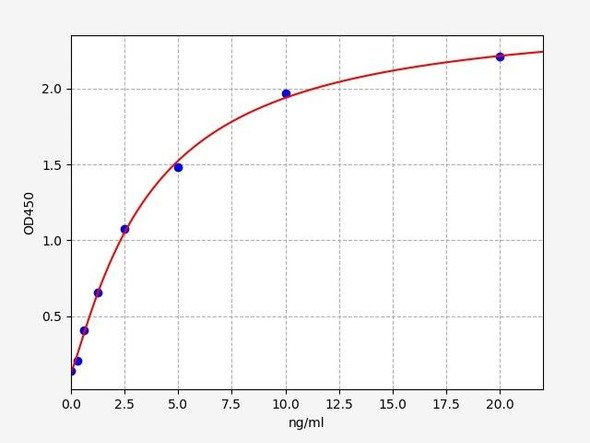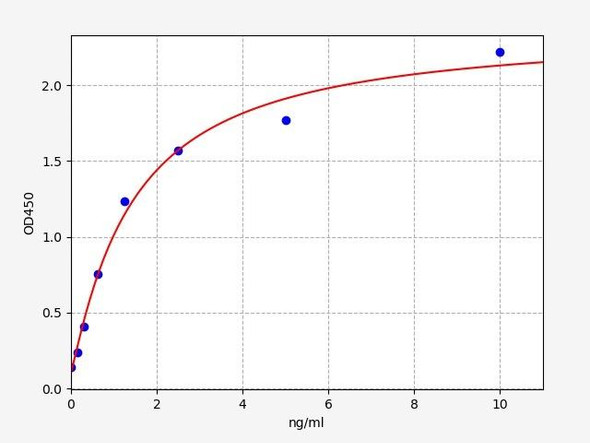Anti-CACNA1A Antibody (CAB20387)
- SKU:
- CAB20387
- Product Type:
- Antibody
- Antibody Type:
- Polyclonal Antibody
- Reactivity:
- Human
- Host Species:
- Rabbit
- Isotype:
- IgG
- Synonyms:
- BI
- Synonyms:
- EA2
- Synonyms:
- FHM
- Synonyms:
- MHP
- Synonyms:
- APCA
- Synonyms:
- HPCA
- Synonyms:
- MHP1
- Synonyms:
- SCA6
- Synonyms:
- DEE42
- Synonyms:
- CAV2.1
- Synonyms:
- EIEE42
- Synonyms:
- CACNL1A4
Description
| Product Name: | CACNA1A Rabbit pAb |
| Product Code: | CAB20387 |
| Size: | 50uL, 100uL |
| Synonyms: | BI, EA2, FHM, MHP, APCA, HPCA, MHP1, SCA6, DEE42, CAV2.1, EIEE42, CACNL1A4 |
| Applications: | WB |
| Reactivity: | Human |
| Host Species: | Rabbit |
| Immunogen: | A synthetic peptide corresponding to a sequence within amino acids 2000-2100 of human CACNA1A (NP_075461.2). |
| Applications: | WB |
| Recommended Dilutions: | WB 1:500 - 1:2000 |
| Reactivity: | Human |
| Immunogen: | A synthetic peptide corresponding to a sequence within amino acids 2000-2100 of human CACNA1A (NP_075461.2). |
| Purification Method: | Affinity purification |
| Storage: | Store at -20°C. Avoid freeze / thaw cycles. Buffer: PBS with 0.02% sodium azide, 50% glycerol, pH7.3. |
| Isotype: | IgG |
| Sequence: | Email for sequence |
| Gene ID: | 773 |
| Uniprot: | O00555 |
| Calculated MW: | 282kDa |
| Observed MW: | Refer to figures |
| UniProt Protein Function: | CACNA1A: Voltage-sensitive calcium channels (VSCC) mediate the entry of calcium ions into excitable cells and are also involved in a variety of calcium-dependent processes, including muscle contraction, hormone or neurotransmitter release, gene expression, cell motility, cell division and cell death. The isoform alpha-1A gives rise to P and/or Q-type calcium currents. P/Q-type calcium channels belong to the 'high-voltage activated' (HVA) group and are blocked by the funnel toxin (Ftx) and by the omega-agatoxin- IVA (omega-Aga-IVA). They are however insensitive to dihydropyridines (DHP), and omega-conotoxin-GVIA (omega-CTx-GVIA). Defects in CACNA1A are the cause of spinocerebellar ataxia type 6 (SCA6). Spinocerebellar ataxia is a clinically and genetically heterogeneous group of cerebellar disorders. Patients show progressive incoordination of gait and often poor coordination of hands, speech and eye movements, due to degeneration of the cerebellum with variable involvement of the brainstem and spinal cord. SCA6 is mainly caused by expansion of a CAG repeat in the coding region of CACNA1A. There seems to be a correlation between the repeat number and earlier onset of the disorder. Defects in CACNA1A are the cause of familial hemiplegic migraine type 1 (FHM1); also known as migraine familial hemiplegic 1 (MHP1). FHM1, a rare autosomal dominant subtype of migraine with aura, is associated with ictal hemiparesis and, in some families, progressive cerebellar atrophy. Defects in CACNA1A are the cause of episodic ataxia type 2 (EA2); also known as acetazolamide-responsive hereditary paroxysmal cerebellar ataxia (APCA). EA2 is an autosomal dominant disorder characterized by acetozolamide- responsive attacks of ataxia, migraine-like symptoms, interictal nystagmus, and cerebellar atrophy. Belongs to the calcium channel alpha-1 subunit (TC 1.A.1.11) family. CACNA1A subfamily. 7 isoforms of the human protein are produced by alternative splicing. |
| UniProt Protein Details: | Protein type:Membrane protein, multi-pass; Channel, calcium; Membrane protein, integral Chromosomal Location of Human Ortholog: 19p13 Cellular Component: cell projection; cell soma; dendrite; cytoplasm; plasma membrane; integral to membrane; voltage-gated calcium channel complex; nucleus Molecular Function:voltage-gated calcium channel activity; protein binding; syntaxin binding; metal ion binding; high voltage-gated calcium channel activity Biological Process: cell death; vestibular nucleus development; musculoskeletal movement, spinal reflex action; gamma-aminobutyric acid secretion; regulation of axonogenesis; adult walking behavior; receptor clustering; cellular chloride ion homeostasis; synaptic transmission; behavioral response to pain; elevation of cytosolic calcium ion concentration; synaptogenesis; neurotransmitter metabolic process; negative regulation of neuron apoptosis; neuromuscular process controlling balance; cell growth; cerebellum maturation; synaptic transmission, glutamatergic; rhythmic synaptic transmission; regulation of acetylcholine secretion; dendrite morphogenesis; calcium ion-dependent exocytosis of neurotransmitter; glucose metabolic process; transmission of nerve impulse; spinal cord motor neuron differentiation; regulation of calcium ion-dependent exocytosis; cerebellar molecular layer development; calcium ion-dependent exocytosis; membrane depolarization; sulfur amino acid metabolic process; cerebellar Purkinje cell differentiation; energy reserve metabolic process; neuromuscular synaptic transmission; hormone metabolic process; regulation of insulin secretion; negative regulation of hormone biosynthetic process; gamma-aminobutyric acid signaling pathway Disease: Spinocerebellar Ataxia 6; Migraine, Familial Hemiplegic, 1; Episodic Ataxia, Type 2 |
| UniProt Code: | O00555 |
| NCBI GenInfo Identifier: | 6166047 |
| NCBI Gene ID: | |
| NCBI Accession: | O00555.2 |
| Molecular Weight: | |
| NCBI Full Name: | Voltage-dependent P/Q-type calcium channel subunit alpha-1A |
| UniProt Protein Name: | Voltage-dependent P/Q-type calcium channel subunit alpha-1A |
| UniProt Synonym Protein Names: | Brain calcium channel I; BI; Calcium channel, L type, alpha-1 polypeptide isoform 4; Voltage-gated calcium channel subunit alpha Cav2.1 |
| UniProt Gene Name: | CACNA1A |
| UniProt Entry Name: | CAC1A_HUMAN |






